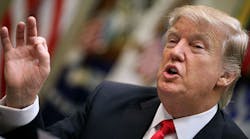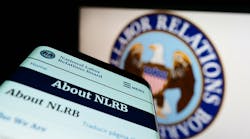It may seem at this point that President Trump hasn’t accomplished much regulatory reform when it comes to workplace rules, but there is a lot going on under the surface.
As we predicted last fall before the election, a Trump election victory would not immediately translate into sweeping regulatory change for a variety of reasons. However, the signs are that it is well on its way.
He already has signed an executive order requiring that for every new regulation issued by a federal agency, it must remove two existing regulations, fulfilling one of his campaign promises. Although no further details about what this covers are available at this time, during the campaign Trump said he planned to exclude regulations that protect public health, safety and security.
The order also doesn’t apply to independent federal agencies and commissions, like the National Labor Relations Board, Equal Employment Opportunity Commission, Surface Transportation Board, Federal Communications Commission and the Federal Trade Commission.
Trump also signaled there are additional regulations he likes when he announced his administration would leave in place the Obama-directed rule banning federal contractors from discriminating against LGBTQ employees and applicants.
The statement issued by the White House declared that, “The executive order signed in 2014, which protects employees from anti-LGBTQ workplace discrimination while working for federal contractors, will remain intact at the direction of President Donald J. Trump.”
Three days after he was inaugurated, the President also signed another executive order requiring a 90-day hiring freeze of federal employees, which is seen as the first step in an effort to fulfill his campaign promise to reduce the size of the government workforce.
Roadblocks to a Fast Start
However, these and other efforts intended to “drain the swamp” in Washington, D.C., as Trump put it, are stalled while Democrats pursue a strategy of massive resistance to the new President, who many declared is not legitimate, and are opposing almost anything he does. This has resulted in substantial delays in the confirmation of many cabinet nominees while Democrats have done everything they can to derail or at least slow down their confirmations.
Although political commentators on the left as well as the right have characterized some of the Democrats’ tactics as self-destructive, evidence supports the notion that Democrat-elected officials facing re-election now have abandoned their earlier strategy that combined selective opposition with compromise because of the fury of members of the party’s left wing, who demanded the massive resistance approach in all cases.
It’s even been suggested that Senate minority leader Sen. Chuck Schumer (D-NY) backed away from an earlier position to quietly allow Jeff Sessions to become Attorney General and led a noisy but futile last-minute opposition to Sessions after Democrat demonstrators showed up at his home angrily demanding that he do so.
Not all of these actions are simply attempts at throwing political red meat to fervent party supporters. A few senators have admitted another motive is to prevent Republican lawmakers from blocking some of the flood of new regulations issued by the Obama Administration in the last few months of his presidency.
Republicans in the House have already resorted to the mechanism contained in the little-known Congressional Review Act, which allows legislators to strike down federal agency regulations within 60 days of their being issued. The House quickly voted to remove two rules issued by the Environmental Protection Agency at the end of 2016. As a result, Democrat lawmakers understand that the more they can gum up the works, the less likely it will be that Republicans can dispose of these rules.
But while his cabinet picks wait their turn, Trump lost little time in appointing new chairs of several independent federal commissions, including the NLRB, which he is allowed to do under the law. Although new commissioners must be nominated by the President and confirmed by the Senate for set terms, a new President is allowed to designate any sitting member of his own party to serve as chairman.
In this case it is Republican Philip Miscimarra, who has frequently dissented from some of his fellow NLRB members’ more novel pro-union innovations in labor law. Two more seats on the five-member board are open and Trump will be able to nominate Republicans to fill those seats. But before the new NLRB can start undoing the damage caused during the Obama era, they will be forced to undergo the same slow-motion gauntlet in the Senate.
Counselor for the Offense
Also still in place until his term ends in November is NLRB General Counsel Richard F. Griffin Jr. Like the board members, he serves for a set term and is nominated by the President.
His role is outsized when it comes to making policy because of the unique way the NLRB is organized. The members of the board forge policy only as part of rulings they make when considering individual unfair labor practice charges. Whether these cases will be referred to the board for decision is generally up to the board’s 46 regional directors under the direct supervision and control of the NLRB general counsel.
Griffin recently supplied a perfect example of why this system is flawed when on January 31 he sent a guidance memorandum to regional directors and other enforcement personnel instructing them to regard Division I college football scholarship players to be employees who can organize into unions and who can collectively bargain over their compensation and working conditions.
The NLRB had declined to assert this position in August 2015 in regard to players at Northwestern University, stating then that asserting jurisdiction over the student-athletes “would not promote stability in labor relations” – and also possibly because it might have proven to be a drag on Democrat candidates in the 2016 elections.
Members of Congress reacted swiftly to Griffin’s new memorandum. On February 2 Virginia Foxx (R-NC), chairwoman of the House Committee on Education and the Workforce, and Tim Walberg (R-MI), chairman of its Subcommittee on Health, Employment, Labor, and Pensions, jointly called for Griffin to “rescind his memorandum immediately” or “step aside as general counsel.”
Foxx and Walberg stressed that the “memorandum puts the interests of union leaders over America’s students, and it has the potential to create significant confusion at college campuses across the nation.”



